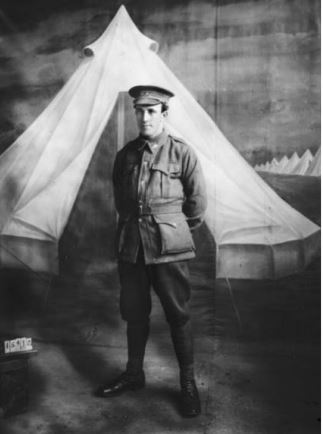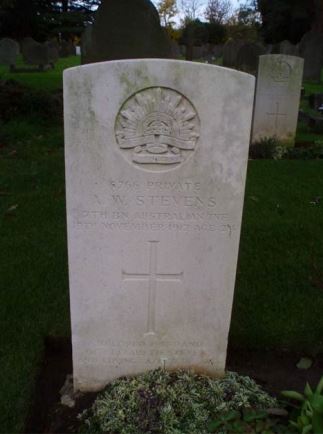7th Battalion, Australian Infantry

Andrew Williams Stevens was wounded twice in the service of his country and the British Empire but died as a result of an accident.
He was born at Moonee Ponds, a suburb of Melbourne, Victoria, Australia in 1893, the son of John and Jane Stevens, 3 Kambrook Road, Caulfield, Victoria. Prior to enlistment his occupation was a ‘stock cutter’ and he was married to Elizabeth Helen Stevens and lived with her at 221 Station Street, North Carlton, Melbourne.
Enlistment was at Melbourne on 6 March 1916 and the initial posting was to the 18th re-enforcement for 7th Battalion, Australian Infantry. After initial training Private Stevens embarked from Melbourne on the troopship Ayrshire bound for Plymouth, England, where he arrived on 2 September 1916. He was sent to 2nd Training Battalion at Perham Downs, Wiltshire before crossing to France on 15 October 1916 and joining up with 7th Battalion (2nd Brigade 1st Australian Division) in the field on 30 November 1916.
On 25 February 1917, during the German retreat to the Hindenburg Line, he suffered a gun shot wound in both thighs and was passed down the casualty route to the 3rd Stationery Hospital at Rouen. On the following day he was on board the Hospital Ship Formosa out of Le Havre en route for England and a bed inside 1st London General Hospital, St Gabriel’s College, Cormant Road, Camberwell, London SE5, where he underwent an operation on 30 March. He was discharged on 26 May 1917 and went on furlough, reporting to the Training Battalion at Perham Downs, Wiltshire on 12 June.
A return to France followed on 23 July 1917 but on the following day he was admitted to hospital at Le Havre with scabies and did not rejoin the 7th Battalion until 20 August 1917.
On 26 October the battalion was in action in the Ypres Salient. It was the opening of the Second Battle of Passchendaele and the final stage of the Battle of Third Ypres. Private Stevens suffered a gun shot wound to his left arm. He was treated initially at the 11th Canadian Field Ambulance, followed by 11th Casualty Clearing Station, before swiftly arriving at 9th General Hospital, Rouen. Although his wound was considered ‘slight’, on 2 November he was put on board the Hospital Ship Panama and sent to England. He was admitted to the Racecourse VAD Hospital at Cheltenham on 3 November.
His wound was healing well and he was down for transfer to an Australian hospital for convalescence. On Sunday 18 November he obtained a pass to spend the afternoon out of the hospital, where he took tea in Cheltenham in the company of Private H Cottell, a fellow recovering wounded Australian. The pair returned at 6pm and as required checked in at their ward. However, they had made some friends when in town and an arrangement was made to meet up with them that evening. Not having permission to leave the hospital the two soldiers slipped out unobserved via the wash house. To avoid contact with the gate porter they walked across some fields on the Evesham side and kept close to a hedge, which ran alongside the Evesham Road, looking for a suitable gap to pass through. A gap was found but it had been blocked up with a five foot high barbed wire fence. Cottell helped Stevens over the fence and he jumped down onto a steep bank. Cottell followed but missed his footing and fell down onto the prostrate form of Stevens, who was lying partly on the road, with his head on the bank, groaning. It was pitch dark, so Cottell struck a match and discovered that in his fall Stevens had knocked his head on stone and injured the back of his head. Cottell assisted Stevens back to the gate house and sought assistance from the porter. Between them they managed to return Stevens to his ward, where Sister Mabel Thorpe discovered the head wound, recognised that his condition was serious and summoned a doctor. The doctor applied treatment but Stevens was in an agitated state and at times barely conscious.
Private Stevens died at 11.40am on the 19 November 1917, aged 24. A post mortem confirmed an extensive fracture to the base of the skull and a haemorrhage on the brain. An Inquest was held on 21 November and the verdict of the jury was that death was due to a fractured skull incurred as a result of an accident; the result of a breach of hospital regulations. Other than being an accomplice on the unauthorised excursion from the hospital no blame was apportioned to Private Cotter. A full report of the Inquest appeared in the Gloucestershire Echo of 21 November 1917.
Private Andrew Williams Stevens was given a military funeral and buried in Cheltenham Cemetery at 3pm on 23 November. The Gloucestershire Volunteers provided a bugler, firing party and pall bearers; 40 Australian soldiers from local hospitals attended, along with staff from the Racecourse VAD Hospital. A cousin, a Dr Stevens of Mount Stuart, Grove Hill, South Woodford, London E18 also attended. In due course the grave was marked by a standard CWGC headstone.
Andrew Stevens’ wife remarried shortly after the end of the war and became Mrs E H Brown.

Researched by Graham Adams 1 March 2013
